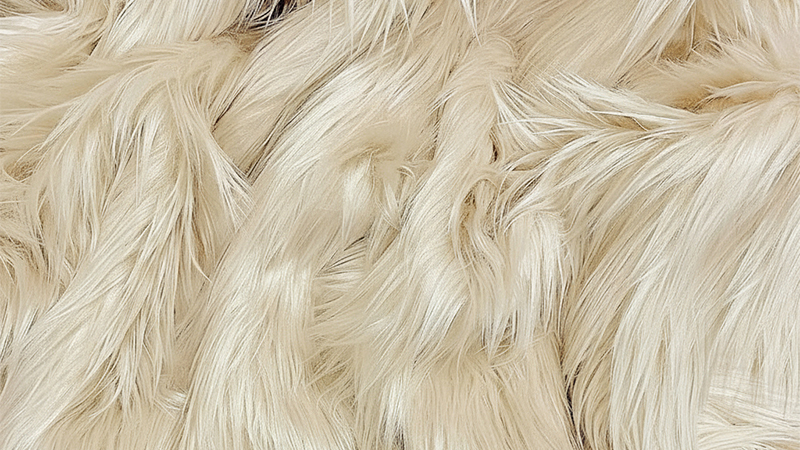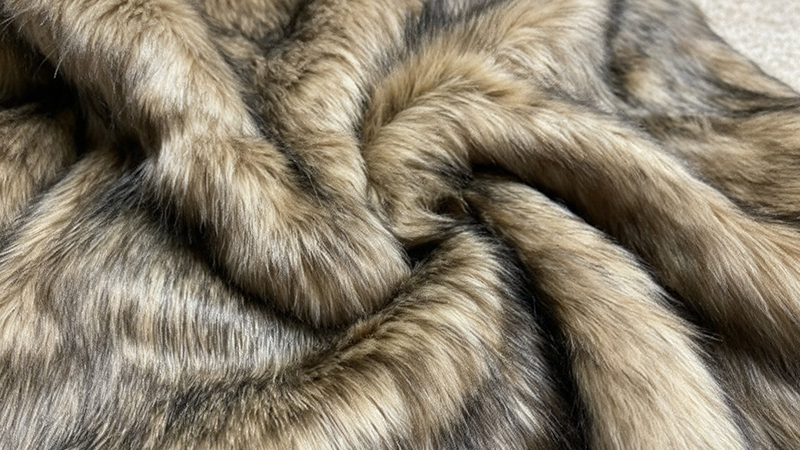
Faux fur fabric has become a fashion favorite for those seeking luxury without compromising ethics. Known for its plush texture and striking appearance, faux fur offers the glamour of real fur while being cruelty-free and more sustainable.
From trendy coats and jackets to stylish accessories, this versatile material adds warmth and sophistication to any wardrobe.
Modern innovations ensure high-quality finishes that mimic natural fur, making it an eco-conscious choice for fashion enthusiasts.
Whether you’re aiming for timeless elegance or contemporary style, faux fur fabric allows you to make savvy, stylish, and ethical choices effortlessly.
What Exactly Does Faux Fur Mean?
The term “faux” originates from French, meaning false, fake, or unnatural. Consequently, faux fur materials are pile textiles meticulously designed to simulate real animal fur, often referred to as fake fur, mock fur, or artificial fur.
These materials boast a wide spectrum of colors and textures, with high-quality versions often being indistinguishable from their natural counterparts.
At its core, faux fur is primarily composed of synthetic fibers like acrylics and modacrylics. These fibers are typically woven onto a base fabric, which can include materials such as silk, wool, or cotton.
A significant advantage of synthetic analogues over animal fur is their cost-effectiveness, abundant supply, superior durability, and enhanced resistance.
Allure of Faux Fur in Modern Fashion
Faux fur has transcended its traditional role to become a chic, cozy, and 100% cruelty-free alternative to genuine animal fur. Its tremendous popularity and versatility make it an indispensable material for crafting stylish and comfortable outerwear and accessories across various seasons and aesthetics.
Beyond its aesthetic appeal, faux fur’s rise is deeply intertwined with ethical considerations, resonating strongly with vegans and individuals committed to animal welfare and environmental care. This material isn’t just about imitation; it’s about conscious luxury and innovative design.
The Diverse Landscape of Faux Fur Types
Faux fur has come a long way from being a simple alternative to real fur. Modern textile technology has allowed designers, crafters, and fashion enthusiasts to explore a wide variety of faux fur types, each offering unique textures, appearances, and functionalities. Understanding this diversity can help you choose the perfect faux fur for fashion, décor, or craft projects.
Short Pile Faux Fur
Short pile faux fur typically features fibers that are 0.5–1 inch in length, creating a sleek and soft texture. Its dense, uniform appearance makes it ideal for fashion items like coats, jackets, and vests.
The smooth surface allows for clean lines and polished silhouettes, making it versatile for both casual and formal wear.
Long Pile Faux Fur
Long pile faux fur has fibers that can range from 1.5 to 4 inches, giving it a shaggy, dramatic look. This type of fur is commonly used for statement pieces, such as bold coats, capes, and oversized accessories. Its voluminous texture adds visual interest, but it requires careful maintenance to prevent tangling or matting.
Plush Faux Fur
Plush faux fur is incredibly soft, often resembling the texture of a teddy bear. Its fibers are dense and velvety, making it a favorite for blankets, throws, and stuffed toys. The luxurious feel of plush faux fur makes it a comfort-centric option in both fashion and home décor.
Textured Faux Fur
Textured faux fur includes a variety of patterns, curls, or waves in its fibers. Examples include curly lamb faux, wavy rabbit faux, or boucle-style textures. This type brings depth and dimension to garments or accessories and is often used to mimic specific animal furs with distinctive patterns, such as sheep or alpaca.
Printed or Patterned Faux Fur
Some faux furs are dyed or printed to replicate animal prints like leopard, zebra, or tiger. These patterned furs allow designers to achieve exotic looks without harming wildlife.
They are highly versatile for fashion statements, accent pieces, or even upholstery, providing a bold aesthetic appeal.
Knitted or Faux Fur Blends
Innovative blends of faux fur with knit fabrics or other textiles have emerged to enhance durability, flexibility, or comfort.
These hybrid fabrics can combine the plush feel of fur with the stretch and breathability of knits, ideal for modern streetwear, loungewear, or accessories like hats and scarves.
Eco-Friendly Faux Fur
With growing awareness about sustainability, eco-friendly faux fur made from recycled materials or biodegradable fibers has gained popularity. These options maintain the luxurious feel of traditional faux fur while minimizing environmental impact.
The Sensory Experience: How Faux Fur Feels and Performs

Faux fur is more than just a visual statement, it’s a tactile adventure. The experience of touching, wearing, and interacting with faux fur engages multiple senses, blending comfort, warmth, and style.
Understanding how different types of faux fur feel and perform can elevate both fashion choices and home décor selections.
The Softness Factor
One of the first things people notice about faux fur is its softness. Plush and velvety, faux fur often mimics the smooth, luxurious touch of real animal fur. The softness varies depending on fiber length and density:
- Short pile faux fur has a silky, smooth texture that glides over the skin, perfect for structured garments like coats or vests.
- Long pile faux fur offers a more dramatic, fluffy feel, giving a sense of indulgence when draped over shoulders or used in oversized accessories.
- Plush or teddy-style faux fur delivers a deep, cushioned softness, making it irresistible for blankets, throws, and stuffed toys.
The Weight and Drape
Faux fur has a distinct weight that contributes to its performance. Heavy faux fur coats provide insulation and a sense of warmth, while lighter furs offer flexibility for layering without sacrificing comfort.
The drape of the fabric also affects its tactile appeal: long, flowing faux fur can create a sense of movement and fluidity, while dense, short fur provides a firmer, more structured feel.
The Warmth Factor
Faux fur excels at retaining warmth due to its dense fibers, which trap air close to the body. While it may not match the natural insulation of some real furs, high-quality faux fur can feel surprisingly cozy, making it ideal for cold climates or winter fashion statements.
The Texture Spectrum
Faux fur offers a wide range of textures, each evoking a different sensory experience:
- Smooth and sleek textures feel refined and modern, ideal for polished fashion looks.
- Curly or wavy textures provide playful, tactile interest and a sense of dimension.
- Patterned or printed furs engage not only touch but also sight, creating a multisensory experience that combines visual intrigue with tactile pleasure.
Durability and Performance
A crucial part of the sensory experience is how faux fur performs over time. High-quality faux fur resists shedding, matting, and tangling, maintaining its softness and appearance through repeated use.
Faux fur can also be machine-washable or easy to maintain, adding practical comfort to the sensory indulgence.
The Psychological Sensation
There’s a subtle psychological element to faux fur. Its plush texture evokes feelings of warmth, safety, and luxury. Wearing or touching faux fur can be comforting, cozy, and even calming, a sensory experience that engages emotion as much as touch.
Faux Fur vs. Real Fur
With advancements in manufacturing, modern faux furs are so remarkably realistic that they can easily be mistaken for genuine mink or beaver. Discerning the difference, however, is straightforward with a few key tests:
Check the Base:
Spread the fur apart with your fingers. If you see a fabric backing, it’s faux fur. The presence of leather or animal skin indicates real fur.
Examine Fiber Tips:
Synthetic fibers are typically machine-cut, resulting in blunt tips, whereas real fur hairs are naturally pointed.
The Burn Test (Caution Advised):
Carefully cut a few strands and burn them on a flame-proof surface. If the odor resembles burnt hair, it’s natural fur. If it smells like melted plastic or paper, it’s faux fur (acrylic, cotton, linen, or rayon).
The Pin Test:
Attempt to push a pin into the base of the fur. If it goes through easily, it’s faux fur, as synthetic bases are often elastic enough to allow the pin to pass. If you encounter significant resistance from a leather-like material, it’s a strong indicator of natural fur.
Weight Difference:
While less definitive, faux fur fabrics are generally lighter in weight compared to real fur.
Longevity and Luxury: Caring for Your Faux Fur Pieces
One of faux fur’s most appealing attributes is its durability and ease of care. Unlike animal fur, it does not attract moths or dust, and its lower cost makes maintenance less daunting. To keep your faux fur pieces in pristine condition:
- Avoid Wet Weather: Do not wear mock fur pieces in the rain.
- Spot Clean: For occasional stains, spot clean by hand using a water spray and a brush. Always allow it to dry naturally; avoid blow-drying.
- Regular Combing: Combing helps maintain its top-notch appearance.
- Professional Cleaning: While hand washing may sometimes be possible, it is highly recommended to use dry-cleaner’s services to prevent any risk of damage.
- Proper Storage: Store faux fur items in a dry and cool closet on a hanger.
Conclusion
Faux fur fabric represents a pivotal shift in the fashion industry, offering a compelling blend of ethical responsibility, versatile design, exceptional durability, aesthetic beauty, and cost-effectiveness.
Its journey from a mere imitation to a celebrated material underscores a growing global consciousness towards animal welfare and environmental sustainability, propelling its popularity worldwide.
By choosing faux fur, you embrace an ethical stance without compromising on style or quality. It is a smart and sophisticated choice for your next fashion statement or creative project, aligning your values with impeccable taste. Experience the luxury, embrace the ethics, and confidently make faux fur your fabric of choice.





